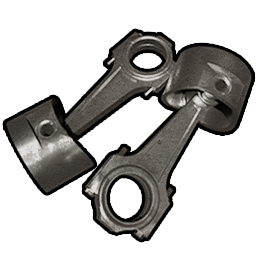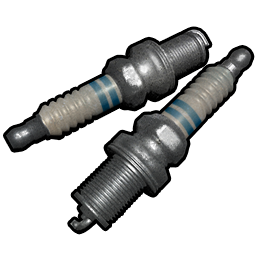Vehicles: What you need to know
5/15 @ 5:00pm EST - The team at Facepunch has provided certain content creators exclusive access this weekend to the upcoming modular vehicles in Rust! Below is an initial look at what there is to know.
5/18 Update - The Vehicles Testing branch is live! See below for information on how to join and check out the devblog here.
Initial look video
Here’s an initial look at Vehicles from Puddy!
How to obtain vehicles
Similar to minicopters, vehicles spawn randomly near roads. At the moment, for testing, there will be about 50 vehicles per 4k map (expect this to change). Found with a semi-random selection of modules equipped, each vehicle will need repairs, fuel, and engine parts prior to being drivable (more on that below).
Repair
Vehicles are repaired in two ways. First, as you’d expect, a Hammer or Garry’s Mod Tool Gun will do the trick. Also, you can repair via the vehicle lift (see below). Modules generally require metal frags and sometimes wood to repair.
If every module on the vehicle reaches zero health, the vehicle becomes a wreck which can no longer be used - although it can be harvested like the scrap helicopter. Once the wreckage is gone, a new vehicle will spawn in the world.
Engine parts
Now that your vehicle is repaired, you’ll need some engine parts. There are 5 types of parts (carburetor, crankshaft, pistons, spark plugs, and valves) and 3 tiers of quality (high, medium, and low).
At least one of each of the 5 parts is required for the engine to function. The quality of part doesn’t matter for getting the engine running, but they do have an impact on the overall speed and fuel efficiency of the vehicle.
Low quality engine parts can be found in junk piles and roadside monuments. Medium and high quality can be purchased at the compound (these prices are not final). Also, you can research and craft low and medium quality parts (high quality can only be purchased).
Below are all the parts (click then hover over the image for more information - all subject to change).
7/1 Edit: Updated these numbers and noted that 1 of each part is now required for the engine to work.
Fuel
Now that the vehicle is repaired and you’ve loaded in your engine parts, you just need to fuel her up and get going. Vehicles run on low grade fuel (accessed in the rear) - no word on if diesel will be added into the mix in the future. As stated above, the efficiency depends on the quality of engine parts you have.
Driving
Ok, you have a working vehicle! You’ll probably want to stick to the roads as these bad boys are not very adept at off-roading. In fact, they have a hard time staying on the road as is.
To enter the driver's seat, just click E when nearby and you’ll mount in. To drive, simply use the WASD keys. To exit, simply hit spacebar (ideally when stationary). If you accidentally roll you’re vehicle, pushing will be an option.
Car locks
What good would a car be if you couldn’t secure it? The process of adding a lock is pretty straightforward. Simply put the vehicle on a lift, and use the UI to add the lock for 75 frags. From the same menu you can create keys and remove locks as well.
With regards to keys (which are 15 metal frags a piece), you can see their ID in the UI and even add a note to help identify each one. Possession of a valid key is required to enter any car with a lock.
Players may still push a car without a key. This means you actually can push a car onto a lift to then remove the lock or create a key.
Damage
To answer the question on everyone's mind: Yes, you can run people over. It does a great deal of damage pretty quickly, so it’s in your best interest not to get hit by a car. You can even run animals over, which is nice. Of course, as you run into things (living and not) the modules on your vehicle will get damaged.
Vehicle lift
So you’ve got a vehicle, now how do you modify it? That’s where the lift comes in. This new deployable can be purchased or researched / crafted. It takes up a good deal of space and requires 20 electricity to run.
Once you’ve got it down, simply drive a vehicle onto it and you’re good to start modifying. Keep in mind, vehicles will not be able to leave the lift without both an engine and drivers seat attached.
Chassis
Now, let’s go into what makes up each vehicle. At its base, there’s the chassis - the framework upon which the rest of the vehicle is built. When it comes to vehicles in Rust, there are 3 varieties of chassis to choose from: small, medium, and large.
Given these are ‘modular’ vehicles, each chassis has a certain number of sockets to which modules can be attached. Each module takes up either 1 or 2 sockets.
Small
Sockets
2
Medium
Sockets
3
Large
Sockets
4
Modules
On the chassis go the modules. Modules have different uses, sockets, conditions, and can be swapped around to various positions on the chassis. You can also pull modules off vehicles and store them like any other item in your inventory.
At the moment there are 10 different modules total. Here is a rundown of each:
Cockpit Vehicle Module
This single module acts as your basic front seat for a driver and passenger.
Crafting Cost
250 metal frags
5 HQM
100 wood
Research Cost
125 scrap
Workbench
Level 2 required
Cockpit with Engine Vehicle Module
Offering a variety of uses, this single module provides seating for two and has a small engine to boot. The small engine has 1 slot for each of the 5 required engine parts.
Crafting Cost
250 metal frags
8 HQM
100 wood
Research Cost
125 scrap
Workbench
Level 2 required
Armored Cockpit Vehicle Module
This single module provides extra protection for the driver and passenger. It even has working metal windows which can be moved up and down to provide cover. And, in case you were wondering, you can go full blown tank mode by wearing heavy armor while driving this bad boy.
Crafting Cost
250 metal frags
5 HQM
50 wood
Research Cost
125 scrap
Workbench
Level 3 required
Engine Vehicle Module
If you want the maximum speed, look no further. This single module acts as a large engine which features slots for 2 pistons, 2 spark plugs, and 2 valves. This means you can produce more power than the smaller engine, especially if you’re using high quality engine parts.
Crafting Cost
250 metal frags
5 HQM
Research Cost
125 scrap
Workbench
Level 2 required
Flatbed Vehicle Module
This is a single module which people can stand as a haphazard mode of player transportation.
Crafting Cost
250 metal frags
100 wood
5 HQM
Research Cost
125 scrap
Workbench
Level 2 required
Large Flatbed Vehicle Module
Like its little brother above, this dual module provides even more space for people to stand on.
Crafting Cost
400 metal frags
250 wood
5 HQM
Research Cost
125 scrap
Workbench
Level 2 required
Fuel Tank Vehicle Module
This is a dual module tank which will be used for transporting fuel in the future. At the moment, however, it only carries water (as Rust doesn’t yet view fuel as a liquid).
Crafting Cost
400 metal frags
100 wood
5 HQM
Research Cost
125 scrap
Workbench
Level 2 required
Passenger Vehicle Module
This dual module provides seating for 6.
Crafting Cost
500 metal frags
250 wood
5 HQM
Research Cost
125 scrap
Workbench
Level 2 required
Rear Seats Vehicle Module
A single module that provides seating for 2.
Crafting Cost
250 metal frags
100 wood
5 HQM
Research Cost
125 scrap
Workbench
Level 2 required
Storage Vehicle Module
Similar to a storage box, this single module provides storage space for up to 18 items.
Crafting Cost
250 metal frags
250 wood
5 HQM
Research Cost
125 scrap
Workbench
Level 2 required
Decay
Given these vehicles are pretty expensive to get running, the developers are being more liberal with the decay times than other modes of transportation. As it stands, vehicles will decay in 216 minutes (a little over 3.5 hours) when left outside. Inside, however, will result in 10x the decay time.
Example vehicles
Here’s a bunch of vehicle variants which are now possible.
Other stuff
Vehicles will set landmines off (and it causes quite a bit of damage)
Locking and ownership are planned (hopefully before release)
Vehicle ramps are planned
























